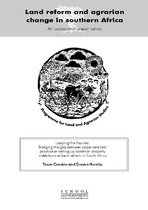Leaping the fissures: Bridging the gap between paper and real practice in setting up common property institutions in land reform in South Africa
Abstract
New common property institutions (CPIs) were created in South Africa soon after 1994 to enable self-constituted groups of people a choice about how they wished to acquire, hold and manage land. They were to provide rural people with an alternative to individual freehold, tribal administration and other legal group ownership options. This form of CPI, created through the Communal Property Associations (CPA) Act 28 of 1996 (the Act), focused on local constitution making as the mechanism for constituting the group and for realising individual and collective self-determination. However, concerns about the viability of these new institutions were voiced within a month of the publication of the Act (Hornby 1996) and in time became an active discourse that declared them to be failing (LEAP 1999). This paper takes a hard look at the claim that these new common property institutions are failing and argues that there are no meaningful indicators against which assessments of success or failure can be made. It asserts that the tenure security of the group and its members should be the primary purpose of land reform CPIs, because secure tenure is the primary mechanism for reducing risk for vulnerable people and is the universal need of the group. Securing tenure of individual members of CPIs, rests upon the clarity and accessibility of procedures for the assertion and justification of property rights and institutional mechanisms for realising and enforcing these rights. Useful indicators of security then become the degree to which these procedures and mechanisms are known, accessible, equitable, clear, used, socially accepted, transparent and enforced. This in turn requires that CPIs are developed from adaptations of current local practices within a broader environment in which there is legal, institutional and technical coherence and support for this approach. Without an enabling legal, institutional and technical framework, the tenure security of members of CPIs will not be significantly improved. It is political choices that inform whether or not this will take place. The paper begins by analysing what the new CPIs were set up to do and the legal and political framework in which they were created. It goes on to reflect on lessons that the Legal Entity Assessment Project (LEAP) has drawn from assessing the situation of land reform CPIs. Using the focus of tenure security and drawing on lessons from tenure work in Africa, the paper then interrogates in depth how membership has been constituted in land reform CPIs and whether the institutional context in which they have been set up has provided adequate support. It concludes by asserting that community constitutions reflect ambiguous and contradictory definitions of membership without reference to local practices and institutions. The state has not supported CPIs institutionally, or acknowledged the importance of institutional linkages at local level or provided legal, institutional and technical coherence. This creates an indeterminacy that puts tenure for members at risk. The analysis leads to some practical suggestions for field and bureaucratic practices. It proposes that prescriptive requirements are replaced by an approach that enables groups to articulate current procedures and institutions, and uses the suggested indicators to achieve gradual adaptation towards greater equity. A framework such as that offered by the Land Rights Bill is needed to provide support for such an approach and thus broader legal and policy reform is necessary.

